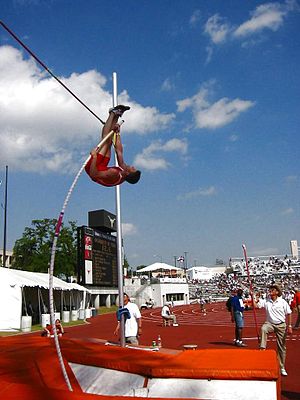Pole-vaulting
|
Athletics Pole vault |
|
|---|---|

An athlete in the middle of the vaulting phase
|
|
| Men's records | |
| World | Renaud Lavillenie 6.16 m (20 ft 2 1⁄2 in) (2014) |
| Olympic | Thiago Braz da Silva 6.03 m (19 ft 9 1⁄4 in) (2016) |
| Women's records | |
| World | Yelena Isinbayeva 5.06 m (16 ft 7 in) (2009) |
| Olympic | Yelena Isinbayeva 5.05 m (16 ft 6 3⁄4 in) (2008) |
Pole vaulting is a track and field event in which a person uses a long, flexible pole (which today is usually made either of fiberglass or carbon fiber) as an aid to jump over a bar. Pole jumping competitions were known to the ancient Greeks, Cretans and Celts. It has been a full medal event at the Olympic Games since 1896 for men and 2000 for women.
It is typically classified as one of the four major jumping events in athletics, alongside the high jump, long jump and triple jump. It is unusual among track and field sports in that it requires a significant amount of specialised equipment in order to participate, even at a basic level. A number of elite pole vaulters have had backgrounds in gymnastics, including world record breakers Yelena Isinbayeva and Brian Sternberg, reflecting the similar physical attributes required for the sports. Running speed, however, may be the most important skill required.
Poles were used as a practical means of passing over natural obstacles in marshy places such as provinces of Friesland in the Netherlands, along the North Sea, and the great level of the Fens across Cambridgeshire, Huntingdonshire, Lincolnshire and Norfolk. Artificial draining of these marshes created a network of open drains or canals intersecting each other. To cross these without getting wet, while avoiding tedious roundabout journeys over bridges, a stack of jumping poles was kept at every house and used for vaulting over the canals. Venetian gondoliers have traditionally used punting poles for moving to the shore from their boat.
...
Wikipedia
